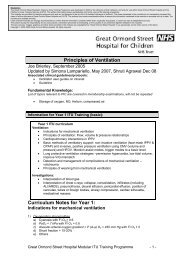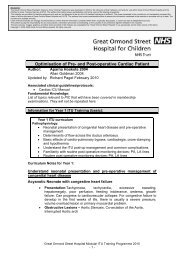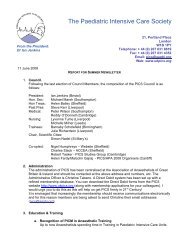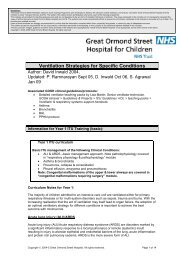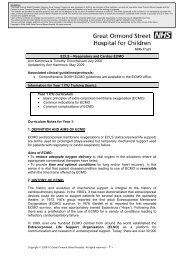Renal Replacement Therapy & Plasmapheresis Quen Mok ... - PICS
Renal Replacement Therapy & Plasmapheresis Quen Mok ... - PICS
Renal Replacement Therapy & Plasmapheresis Quen Mok ... - PICS
You also want an ePaper? Increase the reach of your titles
YUMPU automatically turns print PDFs into web optimized ePapers that Google loves.
Great Ormond Street Hospital Modular ITU Training Programme 2008-2009<br />
The specific therapy used depends on available expertise in the unit, the child’s size and<br />
clinical condition. Also studies show that early dialysis leads to a better outcome with a lower<br />
mortality and a shorter length of stay than starting dialysis late [1]<br />
Transport mechanisms and solute clearance<br />
Dialysis – small molecules easily removed by diffusion<br />
Haemofiltration – as fluid is removed, the solute is cleared by convection (solvent drag).<br />
Solute clearance is therefore dependent on sieving coefficient of solute and ultrafiltrate<br />
removal, which is dependent on the hydrostatic pressure gradient either side of the<br />
membrane. This will depend on blood flow, filter surface area and ultrafiltration rate (%<br />
filtration fraction). Hence middle sized and small molecules can be removed.<br />
Osmosis – movement of water from a higher to lower water concentration<br />
Peritoneal dialysis<br />
Removal of solutes is by diffusion due to an osmotic pressure gradient across the semipermeable<br />
peritoneal membrane. Removal of fluid is achieved with the use of dialysate<br />
solutions containing hypertonic glucose or other osmotically active particles (see figure 2-10<br />
below).<br />
Generally use 10-20 ml/kg volumes with ½ - 1 hour cycles.<br />
Increased clearance by<br />
• Increased dwell time, to a degree<br />
• Increased dialysis volume<br />
• Increased osmolality of dialysis solution<br />
(see figures below)<br />
Copyright © 2008-9 Great Ormond Street Hospital. All rights reserved. - 2 -



